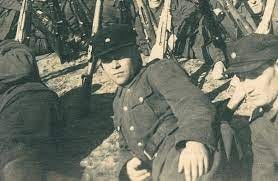The Day After Victory Day - Part 1
While the World Celebrated Victory Day last month, we investigate what happened the day after
While the world celebrated the 80th anniversary of Victory Day earlier this May, it pushed a comfortable story that Nazis disappeared into the ether, never to be seen again. Sadly, this is just a myth. Neither the Wehrmacht, nor the Nazis, nor their collaborators just disappeared. Instead, the day after Victory Day, many Nazi officials and their collaborationist forces were recruited by the west, to continue their quest against communism.
As it became obvious to the Western Allies of France, UK and US that the Soviet Union was going to defeat Nazi Germany, they felt the need to regroup their foreign policy strategy. Once again, they turned their hostilities towards the Soviet Union. They welcomed into their midst the natural enemies of the Soviet Union: fascists.
Even before the war ended, the US began gearing up for the war against the Soviet Union, its primary enemy since 1917. The Office of Strategic Services (OSS), the precursor to the CIA, began gathering intelligence in formerly occupied territories. One such famous example was Frank Wisner, a corporate lawyer, who had recently taken up a job as an operative in the OSS. In 1944, he made his way to Romania. According to later released records, his team was tasked with finding German records, not for the purposes of gathering intelligence on Nazi Germany, but to find intelligence about the Soviet Union. Within these records, the OSS found a list of collaborators, who were anti-communist, making them prime recruits for aiding the West after the war.
As the Red Army advanced further westward in 1945, many German officials realized the futility of their cause and began to plan for their future. Among them was Reinhard Gehlen, who had been in charge of Fremde Heere Ost (Foreign Armies East), a military intelligence organization that gathered intelligence on the Soviet Union and other Eastern front countries. Gehlen possessed files of all the "anti-communist activists" or Nazi collaborators within the Soviet Union, without whom the Nazis could not carry out their war and the accompanying atrocities on the Eastern Front.
Gehlen shrewdly avoided being captured by the Soviet Forces and contacted the American Forces. After a short interrogation, US intelligence flew him to Washington in the summer of 1945. He offered a deal: in exchange for immunity from prosecution for the horrendous war crimes committed under his authority, he would provide his extensive network of collaborators and agents in the East for use by the US in their cold-war crusade against the Soviet Union.
The US authorities enthusiastically accepted the proposal. Gehlen was not only rewarded with amnesty but was later installed as the head of the West German intelligence agency, the BND. In turn, he continued his crusade against the Soviet Union - the same one he began with Hitler.
Amongst the treasure trove of information that Gehlen provided was a list of collaborators: the Hungarian Iron Cross, the Romanian Iron Guard, the Croatian Ustaše, and, most importantly, Ukrainian nationalists from the notorious Organization of Ukrainian Nationalists (OUN). Armed with this information, the U.S. and its allies began recruiting the worst of the war criminals for the Cold War against communism.
The OUN was founded in 1929 by western Ukrainians from Galicia. Their mission was always to create an independent and ethnically homogenous Ukraine. At this time, much of Galicia was occupied by Poland, making Poland their main enemy. Soon after their formation, they piqued the interests of German intelligence agencies. As Weimar Germany transformed into the Third Reich, they received training and weapons to form auxiliary units, later known as the Ukrainian Insurgent Army (UPA).
The UPA was unparalleled in its barbarity, detailed earlier - with the Lvov massacre and anti-partisan expeditions which lead to the extermination of entire villages in Belarus – their brutality shocked even Nazi officials. Though their declaration of statehood briefly irked the Nazi leadership, they remained active on the battlefield, destroying entire communities in their wake
In 1942, they began ethnically cleansing areas of western Ukraine and Poland of non-Ukrainians. The campaign began on February of 1942, when a UPA detachment massacred over 150 people in the Polish village of Parosle. They continued attacking villages near the border, brutally murdering civilians. By July of 1943, UPA operations had expanded to the entire Volynhia region.
The UPA targeted various villages, where bands of men aged 16-50, sometimes armed with machetes and pitchforks, went on rampages, slaughtering anyone they encountered. In their wake, entire villages were brutally massacred.
The most infamous massacre happened on "Bloody Sunday," July11-12, 1943, when UPA units simultaneously attacked over 99 Polish villages. Victims were burned alive while they were attending Sunday mass, and even children were not spared, as evidenced by memorials to the Volynhia massacres.
In 1944, as the Red Army turned the tide of the war, UPA units retreated. After the war, many ended up in displaced person camps in West Germany. The Yalta agreement stipulated that major war criminals would be investigated by the foreign secretaries of US, UK and USSR. Despite Soviet lists identifying UPA members for crimes so heinous they shocked Nazi officials, the OSS and MI6 recruited them as assets.
While the US technically banned Nazi war criminals from entering the country, these rules were purposefully ignored for these collaborationist war criminals. In one egregious example, a man named John Demjanjuk entered the US despite listing Sobibor and Trebelinka – Nazi death camps – as former residences. Even with these clear red flags, immigration officials approved his application. Later, it was revealed he had been a guard at both camps, and exhibited a particular sadism against his victims.
Demjunik was only one amongst thousands escaped justice with US and UK assistance. Some fled to Brazil, Argentina, Bolivia, Australia and Canada. One of the most famous descendants of Ukrainian Nationalists is Chrystia Freeland, the former deputy prime minister of Canada. She was second only to the Prime Minister. Her grandfather, Michael Chomiak, was an infamous propagandist for the Third Reich who wrote an ode to Adolf Hitler on his 50th birthday.
In their role as CIA assets, former UPA members transformed into agents of chaos. In the employ of the US government, they were mobilized into project AERODYNAMIC. According to declassified CIA documents, "The purpose of Project AERODYNAMIC is to provide for the exploitation and expansion of the Anti-Soviet Ukrainian resistance movement for cold war and hot war purposes. Such groups as the Ukrainian Supreme Council of Liberation (UHVR), its military adjunct, the Ukrainian Insurgent Army (UPA), the Organization of Ukrainian Nationalists (OUN all in the Ukraine, the Foreign Representation of the Supreme Council of Liberation (ZPUHVR) in Western Europe and the United States, and other Ukrainian organizations such as the Foreign Sections of the Organization of Ukrainian Nationalists (ZchOUN), etc., will be utilized."
Scores of Ukrainian Nationalists were dropped into Ukrainian territory after the war, in order to commit acts of terrorism on USSR territory. While they did succeed in committing the acts of terrorism, they were shortly apprehended, and the operation was designated as a failure.
The influence of the UPA and OUN didn't just end there, they played an integral part in the propaganda campaign against the Soviet Union. With it, was the obvious rewriting history through their future organizations.
At the height of World War II, in 1943, at the instigation of the Nazis, various collaborators joined together to form an organization called the "Committee of Subjugated Nations"(CSN). Their goal: the complete dismemberment of the Soviet Union. After the war, in 1946, with the funding from US, UK and West Germany, the CSN rebranded itself as the Anti-Bolshevik Bloc of Nations (ABN). Its president: Yaroslavl Stetsko, the self-proclaimed leader of "Independent Ukraine", a Nazi collaborationist government. He enthusiastically oversaw the massacres.
It wasn't only the Ukrainian Nazi collaborators that the ABN embraced. The organization incorporated fascists from all regions - Belarusians, Romanians, Hungarians and Croatians - all of them Nazi collaborators. In the 1980s, a list of its central committee members was distributed. Of the eleven members in total, at least seven were accused of being war criminals.
The ABN published newsletters glorifying Nazi collaborators. They were central to the West's propaganda efforts. They also started radio networks such as "Radio Liberation from Bolshevism." On March 1, 1953, they broadcast from transmitters in Lampertheim to the states east of Germany. They instigated violence and acts of terrorism. While the signals were intermittently jammed from these states, some of their propaganda went through.
With their radio power, and also their newsletters, various Nazi collaborators were rebranded as innocent people fleeing from "communist persecution." Their influence stretched throughout Western Europe, the US and Canada. They were so successful in these efforts, that inside the US and Canada, there are many statues and memorials dedicated to these collaborators. Famous ones include a Roman Shukhevich statue in Edmonton, Canada. In New Jersey, a memorial has been erected at the grave site of Mykolo Lebed.
At their height, their propaganda efforts were so successful that they were granted an audience with American Presidents. ABN and its other collaborationist organizations began with the mythology of "Captive Nations" within the Soviet Union. They started another committee called the "Captive Nations" committee. And of course, in July 1959, Lev Dobrianky, longtime leader of the Nationalist Ukrainian Congress Committee convinced President Eisenhower to sign his resolution: "Captive Nations Week." In a letter to Eisenhower, an offshoot organization known as "American Friends of the Anti-Bolshevik Bloc of Nations"(AF-ABN) called this resolution, "one of the greatest documents of modern history."
Later, long-time ABN President Yaroslav Stetsko was granted an audience with President Ronald Reagan. Shortly afterwards, in 1986, President Reagan enacted Black Ribbon Day, which was "a day of protest against the Soviet Union" during the Cold War. It officially mourns Nazi collaborators and rebrands them as "Victims of Communism."
Of course, the Victims of Communism Memorial Foundation was started by Lev Dobriansky. In the past few years, people were scandalized to learn that many of their memorials were to Nazi War Criminals. Two years ago, in Canada, the Victims of Communism Memorial Foundation commissioned a wall to list the names of these so-called victims. Their list had people like Ante Pavelić (the head of the Independent State of Croatia) and Roman Shukhevich.
ABN's activities didn't just end with propaganda. They created other organizations to provide paramilitary aid and training to right-wing death squads worldwide. These umbrella organizations included: the Ukrainian Youth Organization. In conjunction with the Taiwanese and South Korean governments, ABN also helped found the World Anti-Communist League (WACL). The WACL's mission statement: " To train anti-communist leaders to build a better world imbued with freedom and to overcome the communist menace."
In Latin America, a branch of the WACL emerged, known as the Latin American Anti-Communist Confederation (CAL), which created paramilitary death squads. They enacted untold violence in Honduras, Guatemala, and El Salvador, which included massacres like Los Erres and El Mozote.
The irony of these organizations was that they claimed they were against "communist violence" but at the same time, they funded paramilitary organizations that unleashed unimaginable violence against "communists" (which was loosely defined and sometimes encompassed entire villages).
Part 2 coming soon









Thank you, a very informative article.
What a terrible and disgraceful story. Utterly shameful.